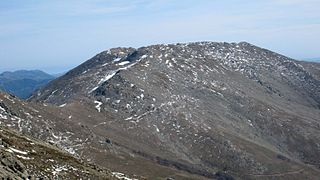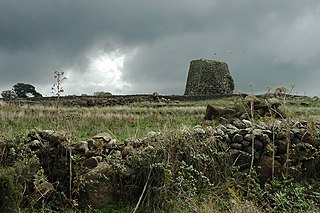
Barbagia is a geographical, cultural and natural region of inner Sardinia, contained for the most part in the province of Nuoro and located alongside the Gennargentu massif.

Logudorese Sardinian is one of the two written standards of the Sardinian language, which is often considered one of the most, if not the most conservative of all Romance languages. The orthography is based on the spoken dialects of central northern Sardinia, identified by certain attributes which are not found, or found to a lesser degree, among the Sardinian dialects centered on the other written form, Campidanese. Its ISO 639-3 code is src.

Sardinia is the second-largest island in the Mediterranean Sea, after Sicily, and one of the 20 regions of Italy. It is located west of the Italian Peninsula, north of Tunisia and immediately south of the French island of Corsica.

Ollolai is a comune at the centre of Barbagia, in the province of Nuoro. Its territory covers an area of 2,734 hectares.

The Judicates, in English also referred to as Sardinian Kingdoms, Sardinian Judgedoms or Judicatures, were independent states that took power in Sardinia in the Middle Ages, between the ninth and fifteenth centuries. They were sovereign states with summa potestas, each with a ruler called judge, with the powers of a king.

The cantu a tenòre is a style of polyphonic folk singing characteristic of the island of Sardinia, particularly the region of Barbagia, though some other Sardinian sub-regions bear examples of such tradition.

The Judicate of Arborea was one of the four independent judicates into which the island of Sardinia was divided in the Middle Ages. It occupied the central-west portion of the island, wedged between Logudoro to the north and east, Cagliari to the south and east, and the Mediterranean Sea to the west. To the north east and beyond Logudoro was located Gallura, with which Arborea had far less interaction. Arborea outlasted her neighbours, surviving well into the 15th century. The earliest known judicial seat was Tharros. The Kingdom of Arborea at the times of its maximum expansion occupied the whole island's territory, except the cities of Alghero and Cagliari.

Atzara is a comune (municipality) in the Province of Nuoro in the Italian region Sardinia, located about 90 kilometres (56 mi) north of Cagliari and about 45 kilometres (28 mi) southwest of Nuoro.

Belvì is a comune (municipality) in the Province of Nuoro in the Italian region Sardinia, located about 80 kilometres (50 mi) north of Cagliari and about 40 kilometres (25 mi) southwest of Nuoro. It is part of the traditional region Barbagia di Belvì.

Bitti is a comune (municipality) in the Province of Nuoro in the Italian region Sardinia, about 140 kilometres (87 mi) north of Cagliari and about 20 kilometres (12 mi) north of Nuoro.

Orani is a comune (municipality) in the Province of Nuoro in the Italian region Sardinia, located about 110 kilometres (68 mi) north of Cagliari and about 15 kilometres (9 mi) southwest of Nuoro. As of 31 December 2004, Orani had a population of 3,113 and an area of 130.8 square kilometres (50.5 sq mi).

Punta La Marmora is a mountain in the Gennargentu range, Sardinia (Italy).

The Sardinians, or Sards, are a Romance language-speaking ethnic group native to Sardinia, from which the western Mediterranean island and autonomous region of Italy derives its name.

Paleo-Sardinian, also known as Proto-Sardinian or Nuragic, is an extinct language, or perhaps set of languages, spoken on the Mediterranean island of Sardinia by the ancient Sardinian population during the Nuragic era. Starting from the Roman conquest with the establishment of a specific province, a process of language shift took place wherein Latin came slowly to be the only language spoken by the islanders. Paleo-Sardinian is thought to have left traces in the island's onomastics as well as toponyms, which appear to preserve grammatical suffixes, and a number of words in the modern Sardinian language.

Salvatore Niffoi is an Italian writer.
Sardinian banditry is a term which describes an outlaw behavior typical of the Mediterranean island of Sardinia, dating back to the Roman Empire. Twentieth-century Sardinian banditry had economic and political overtones.
The Ilienses were an ancient Nuragic people who lived during the Bronze and Iron Ages in central-southern Sardinia, as well as one of the three major groups among which the ancient Sardinians considered themselves divided. After the Sicilian Wars began with the Punic invasion in the sixth century BC, part of them retreated to the mountainous interior of the island, from which they opposed for centuries the foreign rule.
The Barbagian Code can be called a code of behavior not written that prevailed not only in the Barbagia, the Sardinian historical region referred to, but in all the municipalities of province of Nuoro and Ogliastra, in those of Goceano and in some high Oristanese.

The Byzantine age in Sardinian history conventionally begins with the island's reconquest by Justinian I in 534. This ended the Vandal dominion of the island after about 80 years. There was still a substantial continuity with the Roman phase at this time. The invasion of Italy by the Longobards in 568, which changed the face of Italy, only resulted in a few coastal raids on Sardinia.














